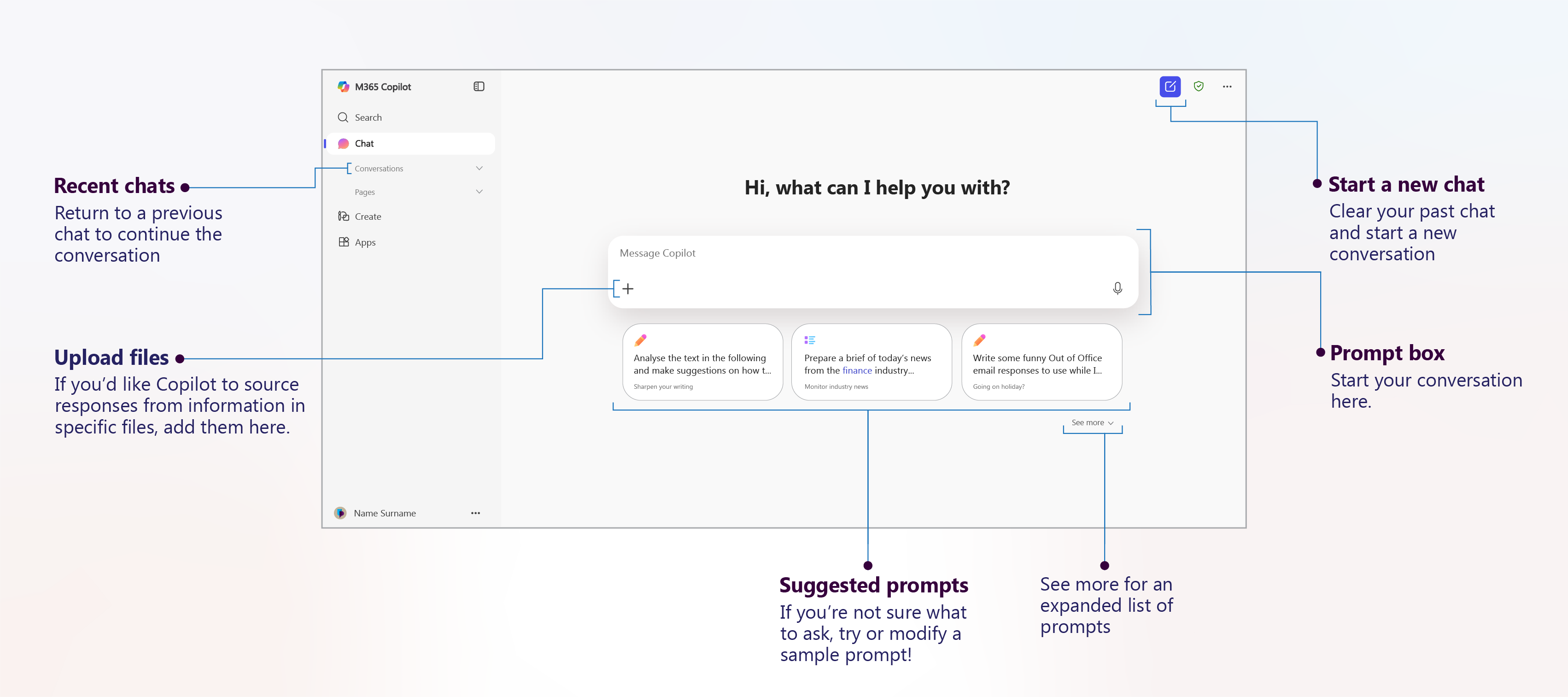

Working with Copilot Chat
Working with Copilot
Welcome to Microsoft 365 Copilot Chat
Copilot Chat has been introduced with your Windows 11 upgrade and promoted as part of the Modern Work Programme objectives around productivity and innovation. It is already integrated with many of the M365 apps that are being rolled-out under the programme and Microsoft continue to strive to integrate it even more throughout their products. More information can be found on the MWP Copilot Chat Product page on the Modern Work Programme Information site.
What is Copilot Chat?
Copilot is a generative AI assistant designed to help users with a wide range of tasks and questions. Copilot understands natural language, making interactions smooth and intuitive. You can ask Copilot anything, and it will provide content and/or helpful responses.
Ways University staff can use Copilot Chat
| Task Type | Description |
|---|---|
| Writing & editing | Draft emails, reports, proposals, or meeting minutes. Improve grammar, tone, and clarity in existing documents. |
| Critiquing text | Suggesting improvements to existing text |
| Summarising content | Summarise long articles, research papers, or meeting notes into key points or executive summaries. Consider summarising long documents such as meeting transcripts and email chains before you share them so the recipient does not have to. |
| Data analysis & visualisation | Analyse spreadsheets, generate charts, graphs, and statistical summaries. Ideal for research or administrative data. |
| Research assistance | Get quick explanations of academic concepts, find sources, or generate literature overviews. |
| Presentation support | Create outlines, talking points, or slide content for lectures, meetings, or conferences. |
| Translation & language help | Translate text between languages or simplify complex language for accessibility. |
| Generate ideas | Generate ideas for projects, events, teaching activities, or research questions. |
| Technical help | Get help with coding, formulas (e.g., Excel), or troubleshooting digital tools. |
| Policy & document drafting | Draft internal policies, guidelines, or templates for university use. |
| Meeting preparation | Create agendas, discussion prompts, or follow-up summaries for meetings. |
| Form & survey creation | Draft questions for surveys, feedback forms, or evaluations. |
| Content repurposing | Adapt existing content for different formats (e.g., turn a report into a blog post, or a lecture into a handout). |
| Accessibility support | Simplify complex language, generate alt text for images, or create accessible document formats. |
| Event planning | Generate checklists, timelines, and promotional content for events or workshops. |
| Feedback analysis | Summarise and categorise open-text feedback from surveys or evaluations. |
| Scenario planning | Thought share potential risks, mitigation strategies, or decision trees for planning. |
| Providing perspectives | Explore viewpoints, compare options, and support critical thinking by offering alternative interpretations or approaches to a document, topic or decision. |
Copilot is an excellent tool, but it is not a substitute for human insight or judgement; please remember to check the output it gives before using it.
About Copilot
Benefits of using Copilot Chat
The statistics below are taken from a Work Trend report that analysed the impact Copilot had on organisations:
- Boost productivity: 70% of users said they got more done, and 68% said it improved the quality of their work.
- Start faster: 85% found Copilot helped them get to a strong first draft more quickly.
- Hard to give up: 77% said that once they started using Copilot, they didn’t want to stop.
Enterprise Data Protection
When you sign in to Microsoft 365 Copilot Chat using your UoP work account, a green shield icon will appear at the top of the chat window. This icon confirms that Enterprise Data Protection (EDP) is active. With EDP enabled, your data is securely managed and protected.
Note: EDP is only active only when you are signed in with your UoP work account. Do not access Microsoft 365 Copilot Chat using a personal account as your interactions will not be protected by EDP. Personal accounts must not be used for any work-related activities.
The Microsoft EDP article contains more information.
Where does Copilot get its information from?
- Current information: Copilot uses Bing to search the web in real time and retrieve up-to-date public information.
- Response generation: Copilot is powered by Microsoft’s large language models (LLMs), including OpenAI’s GPT-4, which is integrated into Microsoft products like Copilot.
- Data sources: These models are trained on a mix of licensed data, publicly available content, and Microsoft proprietary content (such as documentation, support articles, and internal knowledge bases).
Sources Copilot does not use
- Copilot cannot access work related emails, files, Teams chats or University platforms
Prompts
- Prompts and responses are saved for a short period of time so you can review or reuse them. Prompts are are not used to train the LLM model
Using generative AI responsibly
While generative AI such as Copilot offers powerful capabilities, it is not a substitute for human insight or judgement. It is important to understand its limitations and use responsible methods to avoid bias, misinformation, and privacy issues. Some ways to achieve this include:
-
Be transparent: maintain professional integrity by disclosing when content is AI-generated.
-
Check facts: even with the best prompt, AI can make mistakes; verify AI-generated content and linked sources, ensuring it reflects reality and avoids ‘hallucination’.
-
Evaluate language and tone: ensure responses are free from language or assumption that could marginalise any group.
-
Keep data secure: only AI tools approved by the UoP (eg: Copilot) should be used for university business purposes.
-
Maintain IP oversight: responses from generative AI may originate from the same sources which could provide challenges around intellectual property (IP). Ensure human oversight and refinement of AI content to track and verify source provenance and meet copyright requirements
Trainer-led Courses
Copilot Chat training is available to book via Docebo. The session is part of the Modern Work Programme Learning Plan: Windows 11.
Accessing Docebo
- Open a web browser
- Navigate to Docebo
- Select the Blue Single Sign-on button
- Select the relevant Learning Plan to view and enrol on sessions.
The following course is available:
- Using Copilot Chat in Windows 11: A quick-start session covering the key features of Copilot Chat including accessing Copilot and creating prompts.
If you need assistance finding this courses email digitalskills@port.ac.uk.
Microsoft training
Using Copilot
You can access Copilot from the following locations:
Windows 11
- Click on Start Menu.
- Search for 'Copilot'.
- Select Microsoft 365 Copilot, and click on Open.
- Microsoft 365 Copilot will launch.
- To make it easier to access in the future, you can pin Copilot to your taskbar. To do this right-click on the Copilot icon and select 'Pin'.
Microsoft Edge
- Open Microsoft Edge browser.
- A Copilot logo will be shown in the top right corner.
- Click to open. Copilot will be displayed in a panel on the right.
Office.com
- Go to office.com in your web browser.
- Sign in using your University credentials.
- Once logged in, Copilot will launch automatically and be ready to use.
Microsoft Teams
-
Launch Microsoft Teams.
-
Click on ‘Apps’ in the left-hand navigation panel.
-
In the search bar at the top of the Apps panel, type “Copilot” and press Enter.
-
When the Copilot app tile appears, click ‘Open’.
-
Copilot will launch, and its icon will be added to your left-hand navigation panel.
Tip: You can drag the Copilot icon to reposition it closer to the top of the panel for easier access.
Copilot Chat Interface

Images taken form Utilizing Microsoft Copilot Chat
Getting started with Copilot
The instructions below are just to get you started. Please take the time to review the Instructions on creating prompts as this will ensure you get the possible responses from Copilot.
- Type in a simple question in the Prompt box, some examples could include:
- Best things about the University of Portsmouth
- Where are the University of Portsmouth campuses?
- Content to include in a web article on time management
- Schedule for a site seeing tour in and around Portsmouth
- Click the Send button
- The responses will be shown along with a copy button and prompts to refine the answer
- Always check the responses you get from Copilot before using
Writing effective prompts
The more relevant information you include in a prompt, the better the response is likely to be. Providing clear context helps Copilot understand your intent and generate more accurate, helpful answers. However, it's important to avoid making prompts too long or overly complex. When a prompt includes too many ideas at once or lacks structure, Copilot may misinterpret or overlook key parts of your request.
Best Practice:
- Aim for a clear, focused, and detailed prompt that includes the essential information.
- If your request is complex, consider breaking it into smaller parts or using follow-up prompts.
- Remember, you can always refine or expand your prompt within the same conversation to guide Copilot toward the response you need.
-
Copilot defaults to American English spelling so prompts may need to include a request for UK English if required.
An iterative approach helps you get the most out of your interaction—start with clarity, then build as needed.
- Be Clear and focused
- Include relevant details
- Avoid overloading the prompt
- Refine through conversation
An example of a prompt:
I am a marketing assistant at a University, create a 1500 word blog post about the advantages of attending university. Do not include any bullet points. The blog post should be aimed at both parents and students. Include a table with reasons why University of Portsmouth should be considered. This should conclude with the call to action to visit at least 3 universities. Use UK language.
Using voice dictation with Copilot
Copilot now supports a powerful new way to interact hands-free with voice input. This feature is a game changer for fast, natural language prompting; perfect for multitasking or enhancing accessibility.
- Tap the Microphone Icon in the chat box to activate voice dictation (you may need to allow Copilot access to your microphone and if so, a notification will appear on screen for you to accept or decline).
- Speak clearly and naturally, just like you’re talking to a person and watch your words appear instantly in the prompt box.
- Refine or continue the conversation by speaking again or typing follow-ups.
Creating and saving prompts
Saving your prompt
- Click on the prompt you would like to save.
- A pop-up menu will display select 'Save Prompt' (ribbon).
- In the 'Save this prompt' dialogue box enter a meaningful name for the prompt.
- Select 'Save'.
Using a saved prompt
- Click on the 'View Prompts' link. This will appear either near the bottom of the Copilot screen or next to the Suggestions for Refinement. Look for a square icon with a star.
- The Copilot Prompt Gallery will display.
- Select the 'Your prompts' tab.
- Your saved prompts will display click the one you wish to use.
Reviewing previous prompts
- On the left-hand side of the screen, you'll see a pane displaying your recent prompts.
- Click on any prompt to view the response you previously received.
- To continue refining the output, simply type your message into the 'Message Copilot' box and press Enter on your keyboard.
Using Copilot to summarise meeting documents
Copilot is excellent at summarising long documents such as email threads or meeting transcripts.
Meeting organisers are encouraged to generate the AI summary before sharing the full transcript. This ensures recipients receive a concise overview without needing to process the transcript themselves, reducing unnecessary AI processing and supporting more sustainable digital practices.
Below are some prompts you may want to include when instructing Copilot to summarise a meeting transcript
- Summarise this meeting transcript into key points.
- Give me a bullet-point summary of the main topics discussed.
- What were the main decisions and actions from this meeting?
- Create a short executive summary of this meeting.
- List all action items and who is responsible for each.
- What follow-up tasks were mentioned in this meeting?
- Extract all deadlines and assigned responsibilities.
- Summarise what [Name/Role] contributed during the meeting.
- Group the discussion points by topic or department.
- What were the key concerns raised by the academic staff
- Turn this transcript into formal meeting minutes.
- Generate a summary suitable for emailing to attendees.
- Create a post summarising this meeting.
Prompt gallery
The Prompt Gallery contains a catalogue of prompts created by Microsoft. To view the Prompt Gallery:
-
Open Copilot.
-
Start a new chat and press Enter to initiate the conversation.
-
After Copilot provides suggestions for refinement, the ‘View prompts’ icon will appear.
-
Click on the icon and navigate to the ‘Microsoft prompts’ tab.
-
Select ‘See all prompts’ located at the bottom right of the panel.
-
Use the ‘Task’ and ‘Job type’ filters to narrow down and locate relevant prompts.
-
Click on a prompt to apply it directly in your chat.





